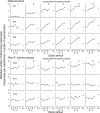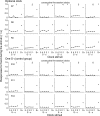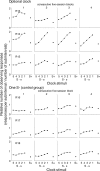Observing responses and serial stimuli: searching for the reinforcing properties of the S-
- PMID: 20354600
- PMCID: PMC2732326
- DOI: 10.1901/jeab.2009.92-215
Observing responses and serial stimuli: searching for the reinforcing properties of the S-
Abstract
The control exerted by a stimulus associated with an extinction component (S-) on observing responses was determined as a function of its temporal relation with the onset of the reinforcement component. Lever pressing by rats was reinforced on a mixed random-interval extinction schedule. Each press on a second lever produced stimuli associated with the component of the schedule in effect. In Experiment 1 a response-dependent clock procedure that incorporated different stimuli associated with an extinction component of a variable duration was used. When a single S- was presented throughout the extinction component, the rate of observing remained relatively constant across this component. In the response-dependent clock procedure, observing responses increased from the beginning to the end of the extinction component. This result was replicated in Experiment 2, using a similar clock procedure but keeping the number of stimuli per extinction component constant. We conclude that the S- can function as a conditioned reinforcer, a neutral stimulus or as an aversive stimulus, depending on its temporal location within the extinction component.
Keywords: clock stimuli; conditioned reinforcement; lever pressing; observing responses; rats.
Figures





Similar articles
-
Resistance to change and relapse of observing.J Exp Anal Behav. 2012 May;97(3):281-304. doi: 10.1901/jeab.2012.97-281. J Exp Anal Behav. 2012. PMID: 22693359 Free PMC article.
-
Disruption of responding maintained by conditioned reinforcement: alterations in response-conditioned-reinforcer relations.J Exp Anal Behav. 2006 Sep;86(2):197-209. doi: 10.1901/jeab.2006.12-05. J Exp Anal Behav. 2006. PMID: 17002227 Free PMC article.
-
[The effects of stimulus duration, component duration, and schedule of stimulus presentation on the observing response in rats].Shinrigaku Kenkyu. 1991 Oct;62(4):235-43. doi: 10.4992/jjpsy.62.235. Shinrigaku Kenkyu. 1991. PMID: 1806680 Japanese.
-
Conditioned reinforcement and response strength.J Exp Anal Behav. 2010 Mar;93(2):269-89. doi: 10.1901/jeab.2010.93-269. J Exp Anal Behav. 2010. PMID: 20885815 Free PMC article. Review.
-
Quantitative analyses of observing and attending.Behav Processes. 2008 Jun;78(2):145-57. doi: 10.1016/j.beproc.2008.01.012. Epub 2008 Jan 31. Behav Processes. 2008. PMID: 18304761 Free PMC article. Review.
Cited by
-
Observing ben wyckoff: from basic research to programmed instruction and social issues.Behav Anal. 2011 Fall;34(2):149-70. doi: 10.1007/BF03392246. Behav Anal. 2011. PMID: 22532737 Free PMC article.
-
Observing responses: maintained by good news only?Behav Processes. 2010 Sep;85(1):80-2. doi: 10.1016/j.beproc.2010.06.002. Epub 2010 Jun 11. Behav Processes. 2010. PMID: 20542098 Free PMC article.
-
Revisiting the role of bad news in maintaining human observing behavior.J Exp Anal Behav. 2010 Mar;93(2):157-70. doi: 10.1901/jeab.2010.93-157. J Exp Anal Behav. 2010. PMID: 20885808 Free PMC article.
-
Gambling in rhesus macaques (Macaca mulatta): The effect of cues signaling risky choice outcomes.Learn Behav. 2017 Sep;45(3):288-299. doi: 10.3758/s13420-017-0270-5. Learn Behav. 2017. PMID: 28421468 Free PMC article.
References
-
- Bersh P.J. The influence of two variables upon the establishment of a secondary reinforcer for operant responses. Journal of Experimental Psychology. 1951;41:62–73. - PubMed
-
- Dinsmoor J.A. Observing and conditioned reinforcement. Behavioral and Brain Sciences. 1983;6:693–728 (includes commentary).
Publication types
MeSH terms
LinkOut - more resources
Full Text Sources

